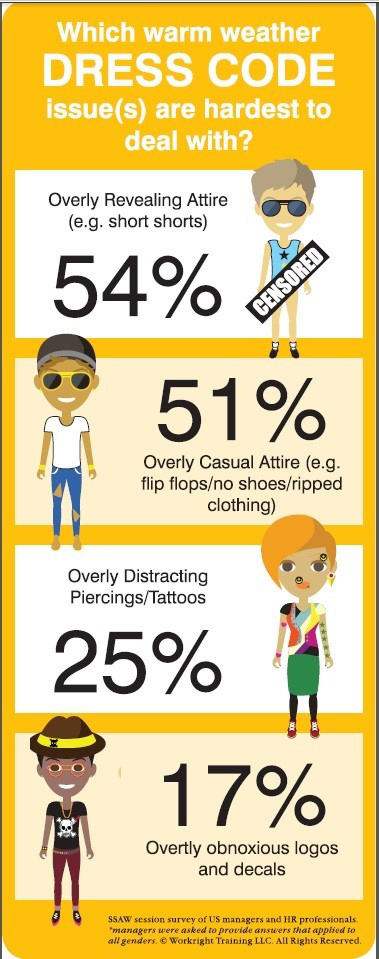A survey of over 400 managers, conducted by legal compliance and consulting services company Seyfarth Shaw at Work, revealed that more than 50% of managers have experienced obstacles or discomfort when dealing with employees sporting overly revealing/casual summer clothing. Additionally, newly exposed piercings, tattoos, logos, and decals have also given managers hot-weather headaches. The infographic below highlights more key findings from this survey. As an addition to these findings, attorney Philippe Weiss, Managing Director of Seyfarth Shaw at Work, suggests the following for business leaders:
- Prep with a policy . . . PRE-summer. Develop and distribute a specific Summer Dress Code policy—before facing the heat. Include examples of what is not (and, if helpful, what is) summer-appropriate attire. Resist the urge, however, to include any photos/images of “what not to wear.” Then explain, and train this new policy.
- ‘Float’ toward summer casual season. Some companies experiment with a “floating” casual day, where employees can pick a day each week to “come-in-casual” (so long as no key customer/client meeting is planned). By allowing employees to “Dress Your Way, One Day” each week, companies can identify and address issues earlier/throughout the year, thereby avoiding a potential dress code drama deluge on day one of warm weather.
- Don’t mangle dress code management moments. Supervisors often get tongue-tied (or way too descriptive) when advising staff members of potential dress violations. Develop higher-level “Dress-Code Designees” who are trained to appreciate privacy concerns and to safely describe your company “Dresspectations.”
- It’s about the apparel, not the anatomy. Dress code conversations should be focused on the apparel standard—not on your employee’s specific skin vs. clothing ratio.
Finally, once you have a policy, team, and plan in place—don’t panic. Courts tend to support reasonable dress code enforcement. And sometimes the solution is as simple as adding a layer or turning a shirt inside out to address a risky/risqué slogan.

